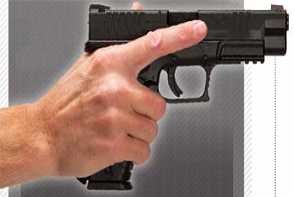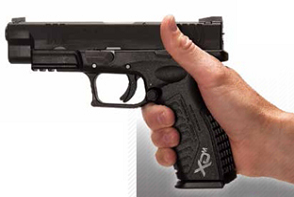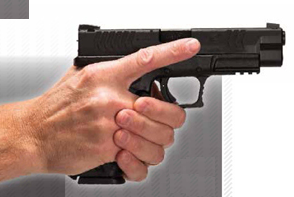I am Terri. I can remember this being just like it was when I was in school. The teacher gave us a topic and then told us we need to write a report on that subject. James, my concealed carry instructor, told me I needed to research some pistols, just like doing research in school. He gave me the manufacturer names and some model numbers of guns. He told me to start looking, and only looking, for information on each of these gun models. I should find out how big they are, how much they weigh, what kind of ammunition they use, everything that I could find out. These pistols were ones that he felt might be my best concealed carry. Each one could be a good fit for me to carry. He said just look at each one online, don't go to a gun store. They may give me some wrong information. He said I was not at the point where I was ready to buy a pistol, he would help me with that later. The only time I would go to a gun store is when I knew exactly what I wanted to buy, and could tell the clerk the manufacturer and model number of the pistol that I want. I need to be past the point where I had to ask questions, and could ask for the exact make and model of pistol that I want. He would help me get there.
James told me that research is the best thing that I could do at this point. Once I had gathered information on each of the pistols he would spend time with me at the range. He has each of the pistols that he told me to research. He felt that my position as a real estate agent indicates that I should carry a .380 caliber or 9mm pistol for protection. The pistols he gave me to research are all smaller, and can easily be concealed in my purse or handbag. None of them are revolvers, all have short barrels. The grips are small enough for me to hold very easily.
James felt that I should probably go with a 9mm. I thought so too. I especially liked the Kahr PM9. I can't say why because at that point I had not even touched any of the pistols. I just picked out one to start off with. James also brought the Kimber Micro .380 ACP, Walther PPK .380 ACP, and the Kel-Tec PF-9 to the range where we met. These were all the pistols that he had me research. He told me that I would be able to fire each one after he had given me some instructions.
James started off telling me basic safety rules. He had dummy guns of all the real pistols that he brought to the range to demonstrate with. He said I should always keep the muzzle of the pistol pointed in a safe direction. The range that we were in had a rule that all weapons had to pointed at a 45 degree angle downward when not in a firing position or ready to fire at a target. Next he let me hold one of the dummy guns that was in the shape of a Kimber Micro .380. He told me that I should always keep my trigger finger, that's on my right hand, since I'm right handed, off the trigger outside the trigger guard. He said even though we are using a dummy gun now, let's assume that it is real. He asked me to show him how I was to point my pistol when I was not ready to fire at a target. I pointed it at a 45 degree angle to the ground in front of me. He said that's great! The only time that I was to put my finger inside the trigger guard and on the trigger was when I was about to fire at a target down range.
 |
 |
 |
James then demonstrated the proper grip of the pistol to me again. My left hand was to hold the grip of the pistol firmly with four fingers. My left thumb was at the side of the pistol. My right small finger, right ring finger, and right middle finger gripped over my left hand with my right trigger finger along the side of the pistol outside the trigger guard. My right thumb rested on top of my left thumb at the top of the pistol grip. I practiced a while with the dummy guns to see which one had the most comfortable grip to me. I finally changed my mind from the Kahr PM9 to the Kimber Micro .380. It had the most comfortable feel. It was my best concealed carry.
James said he thought my choice was a great one for me. This pistol is single action which means I have to cock it before I fire the first shot, but for each shot after that I just pull the trigger. The action of the slide on my first shot will cock the hammer for my next shot. The pistol has a light trigger pull, so it is easy to shoot. I really like the sights, I just line up those three dots and I can hit my target. The thumb safety for the pistol is just right for my thumb to reach so it fits well in my hand.
James said that another main rule that I should always follow is that I should always assume that a pistol is loaded. As soon as you pick up a pistol, always point it to a safe direction, then clear it. With the Kimber .380 he said to clear it I release the magazine, then pull the slide back so that I can look in the ejection slot. If there is a round in the chamber it will eject. Even after clearing a pistol, always assume that it is loaded and point it in a safe direction.
He said I should never load a pistol unless I am ready to shoot. I said that I plan on using my pistol for home protection as well as concealed carry. He said in that case keep it loaded, but in a place where I would be the only one to have access to it. Since I don't have any children that is not a real problem. I can see where women who have small kids would have a problem with keeping their pistol away from little hands.
Finally we got to the point where I could actually fire my new pistol. James showed me how to load the magazine and insert it into the pistol. He said that when I fire the pistol I should always be aware of where each shot is going. I am responsible for every shot that I fire, even the ones that do not hit my target. That means that if I fire at an attacker I can't just blast away with errant shots, I need to know where each shot is going to hit and what they might hit if they go through or miss my target.

